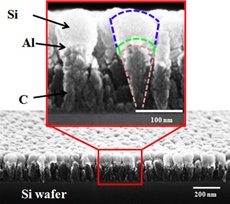“Nanoscoops” could spark new generation of electric automobile batteries
10 Jan 2011
Researchers at Rensselaer Polytechnic Institute have developed an entirely new type of nanomaterial that could enable the next generation of high-power rechargeable lithium (Li)-ion batteries for electric automobiles, laptop computers, mobile phones, and other devices.
 |
| Researchers at Rensselaer Polytechnic Institute developed an entirely new type of nanomaterial that could enable the next generation of high-power rechargeable lithium (Li)-ion batteries for electric automobiles, laptop computers, mobile phones, and other devices. The material, called a ''nanoscoop'' because it resembles a cone with a scoop of ice cream on top, is shown in the above scanning electron microscope image. Nanoscoops can withstand extremely high rates of charge and discharge that would cause today's Li-ion batteries to rapidly deteriorate and fail. |
The material, called a ''nanoscoop'', because it resembles a cone with a scoop of ice cream on top, can withstand extremely high rates of charge and discharge that would cause today's Li-ion batteries to rapidly deteriorate and fail.
An entirely new type of nanomaterial developed at Rensselaer Polytechnic Institute could enable the next generation of high-power rechargeable lithium (Li)-ion batteries for electric automobiles, as well as batteries for laptop computers, mobile phones, and other portable devices.
The new material, dubbed a ''nanoscoop'' because its shape resembles a cone with a scoop of ice cream on top, can withstand extremely high rates of charge and discharge that would cause conventional electrodes used in today's Li-ion batteries to rapidly deteriorate and fail. The nanoscoop's success lies in its unique material composition, structure, and size.
The Rensselaer research team, led by Professor Nikhil Koratkar, demonstrated how a nanoscoop electrode could be charged and discharged at a rate 40 to 60 times faster than conventional battery anodes, while maintaining a comparable energy density.
This stellar performance, which was achieved over 100 continuous charge / discharge cycles, has the team confident that their new technology holds significant potential for the design and realisation of high-power, high-capacity Li-ion rechargeable batteries.






























